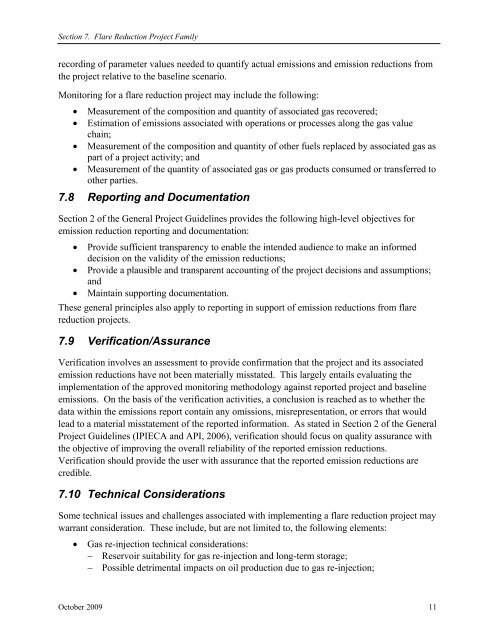Part III: Flare Reduction Project Family - IPIECA
Part III: Flare Reduction Project Family - IPIECA
Part III: Flare Reduction Project Family - IPIECA
Create successful ePaper yourself
Turn your PDF publications into a flip-book with our unique Google optimized e-Paper software.
Section 7. <strong>Flare</strong> <strong>Reduction</strong> <strong>Project</strong> <strong>Family</strong><br />
recording of parameter values needed to quantify actual emissions and emission reductions from<br />
the project relative to the baseline scenario.<br />
Monitoring for a flare reduction project may include the following:<br />
• Measurement of the composition and quantity of associated gas recovered;<br />
• Estimation of emissions associated with operations or processes along the gas value<br />
chain;<br />
• Measurement of the composition and quantity of other fuels replaced by associated gas as<br />
part of a project activity; and<br />
• Measurement of the quantity of associated gas or gas products consumed or transferred to<br />
other parties.<br />
7.8 Reporting and Documentation<br />
Section 2 of the General <strong>Project</strong> Guidelines provides the following high-level objectives for<br />
emission reduction reporting and documentation:<br />
• Provide sufficient transparency to enable the intended audience to make an informed<br />
decision on the validity of the emission reductions;<br />
• Provide a plausible and transparent accounting of the project decisions and assumptions;<br />
and<br />
• Maintain supporting documentation.<br />
These general principles also apply to reporting in support of emission reductions from flare<br />
reduction projects.<br />
7.9 Verification/Assurance<br />
Verification involves an assessment to provide confirmation that the project and its associated<br />
emission reductions have not been materially misstated. This largely entails evaluating the<br />
implementation of the approved monitoring methodology against reported project and baseline<br />
emissions. On the basis of the verification activities, a conclusion is reached as to whether the<br />
data within the emissions report contain any omissions, misrepresentation, or errors that would<br />
lead to a material misstatement of the reported information. As stated in Section 2 of the General<br />
<strong>Project</strong> Guidelines (<strong>IPIECA</strong> and API, 2006), verification should focus on quality assurance with<br />
the objective of improving the overall reliability of the reported emission reductions.<br />
Verification should provide the user with assurance that the reported emission reductions are<br />
credible.<br />
7.10 Technical Considerations<br />
Some technical issues and challenges associated with implementing a flare reduction project may<br />
warrant consideration. These include, but are not limited to, the following elements:<br />
• Gas re-injection technical considerations:<br />
− Reservoir suitability for gas re-injection and long-term storage;<br />
− Possible detrimental impacts on oil production due to gas re-injection;<br />
October 2009 11

















